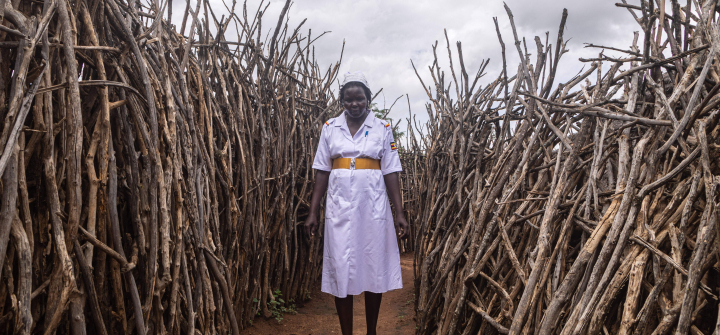Breaking the ‘XX Paradox'
Women are the driving force behind global health. They make up 70% of the global health workforce and 90% of frontline health workers, yet they hold only 25% of senior decision-making roles in the field.
Why are women are not progressing into leadership roles?
A new report from Women in Global Health (WGH), The State of Women and Leadership in Global Health, points to the “XX Paradox”: the theory that if senior leadership roles were awarded on merit alone, women would hold the majority share of those roles in the health sector.
In an email interview with GHN, Ann Keeling, senior fellow for WGH and the report’s lead author, explained the report’s findings, what they mean for women working in health globally, and how solutions can lead to greater gender equity.
Why is it so important to recognize the “XX Paradox” now?
There is evidence that women lost ground in health leadership in the early years of the COVID-19 pandemic, and although they appear to have regained their pre-pandemic numbers, we cannot reinstate the pre-pandemic status quo and ask women to carry on with inequality as usual.
COVID-19 not only exposed the inequalities in health that must now be put right, but it also demonstrated the risks of marginalizing the professional knowledge and perspectives of the women who know health systems best. That marginalization has contributed to the demoralization and burnout of women health workers, who are now resigning in significant numbers.
There was a global health worker shortage of 10 million at the start of the pandemic. We cannot afford to lose trained health workers.
What are the systemic elements that prevent women from ascending to positions of power in global health?
Women tend to be clustered into sectors in health that are given lower status and lower pay e.g., nursing rather than surgery. This can be driven by gender stereotypes of jobs and/or limited education.
Women from India reported pressure from family not to aspire to leadership roles and to focus on home as their primary duty. Gender stereotypes may privilege men in leadership competitions, where men are seen as “natural leaders.”
Men may receive more sponsorship and backing from senior leaders, the majority of whom are men, to advance in their careers. This may be most obvious in political backing for leadership in global health roles.
[Other factors include] “the motherhood penalty,” men not sharing equally the workload of domestic work and childcare, and intersectional biases.
How did the pandemic exacerbate this issue?
The pandemic put exceptional stress on women health workers who were the majority in patient facing roles. It came on top of the gender inequities they were already facing in the health sector—a gender pay gap of 24%; large numbers unpaid; widespread sexual harassment; PPE designed for men’s bodies that did not fit women; [and] unequal career progression and decision-making power.
Health workers in around 100 countries went on strike for increased pay and better protection, creating additional pressure that’s contributed to burnout and attrition amongst all health workers, particularly women.
The report references a “broken pipeline” between women working in national health systems and global health leaders. Where is the disconnect?
People largely progress into global health leadership roles from national health systems. Women fall behind in leadership at national level and therefore do not make it to the global level. Many of the global health positions with power are nominated by national governments. For example, the chief delegates who are the decision makers at the annual World Health Assembly are all nominated by their national governments. In the last 70 years, no more than 30% of chief delegates have been women.
What solutions does the report propose for creating greater gender equity?
Many political commitments have been made in the last 70 years supporting an equal role for women in decision making, but implementation is critical now. Our recommendations include:
- Changing the narrative: Seeing women in health as leaders in their own fields and drivers of change, rather than primarily service users. We need to re-examine the concept of leadership and recognize that women community workers, for example, may be health leaders in their area [and] deserve recognition.
- Affirmative action: Such as quotas and all-women shortlists for filling leadership roles. These can be interim measures to redress the gender imbalance and removed when no longer needed.
- Fixing system bias, not women: Individual measures to train women will not be effective if systems and organizational cultures are biased against them. We must acknowledge and address systemic bias to drive sustainable change.
- Collective action: Since systemic change is needed, women will be more effective working collectively through trade unions, professional associations, and global movements.
- Gender transformative leadership: Beyond gender parity, we argue that decision making groups should be as diverse as the populations the serve. However, sustainable change requires all health leaders to be gender transformative leaders, intentionally addressing gender inequality in health. This is not solely an issue that women and women leaders are responsible for fixing. Everyone stands to benefit from gender equity in health.
How would the future for global health change with more women in leadership?
Women have the right to equality in decision-making roles. When they achieve equality, men and women will have female leadership role models and mentors currently missing now.
Enabling women to access health leadership equally will also increase the morale and reduce attrition amongst women health workers. Gender equal leadership in health will have a “gender triple dividend”: a health dividend strengthening health systems’ decision making and aiding recruitment and retention; a gender dividend since women will gain both income and agency; and an economic dividend since stronger health systems and new health jobs created and filled will drive economic growth.
This is not therefore solely a “women’s issue.” It has benefits for the whole of society.
Ed. Note: This interview was edited for clarity and length.
Join the 50,000+ subscribers in 170+ countries who rely on Global Health NOW summaries and exclusive articles for the latest public health news. Sign up for our free weekday newsletter, and please share the link with friends and colleagues.
Akol Anna Grace, an assistant nursing officer of Kopoth Health Centre, poses between houses during a home visit in Kopoth, Karamoja region, Uganda, on May 25, 2022. Badru Katumba/AFP via Getty





